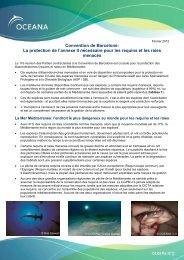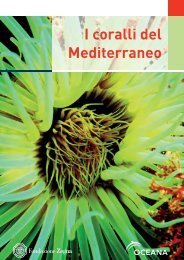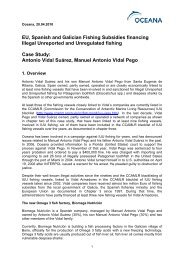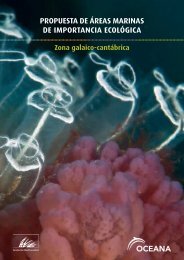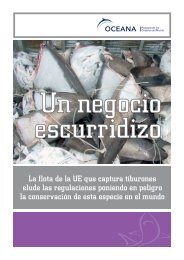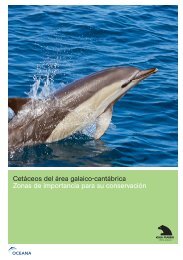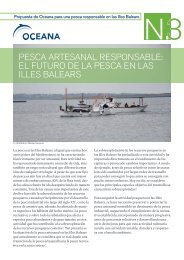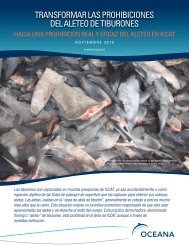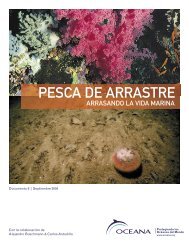Download - Oceana
Download - Oceana
Download - Oceana
Create successful ePaper yourself
Turn your PDF publications into a flip-book with our unique Google optimized e-Paper software.
CHORDATA: TUNICATA<br />
Aplidium elegans Halocynthia papillosa<br />
Aplidium proliferum Polycitor adriaticus<br />
Aplidium nordmanni Pycnoclavella nana<br />
Ecteinascidia turbinata Synoicum blochmanni<br />
CHORDATA: PISCES<br />
Anthias anthias Pagrus pagrus<br />
Chromis chromis Parablennius pilicornis<br />
Coris julis Parapristipoma octolineatum<br />
Ctenolabrus rupestris Plectorhinchus mediterraneus<br />
Diplodus annularis Pomadasys incisus<br />
Diplodus bellottii Scorpaena loppei<br />
Diplodus cervinus Scorpaena notata<br />
Diplodus sargus Scorpaena porcus<br />
Diplodus vulgaris Serranus cabrilla<br />
Halobatrachus didactylus Serranus scriba<br />
Labrus bergylta Symphodus tinca<br />
Pagrus auriga Tripterygion delaisi<br />
AREAS WHERE THIS HABITAT IS PRESENT AND DOCUMENTED BY OCEANA<br />
LOCATION COUNTRY COORDINATES<br />
In front of PN Doñana, Gulf of Cádiz Spain 37º01,01300’N 06º 49,39400’W<br />
In front of PN Doñana, Gulf of Cádiz Spain 37º01,60400’N 06º 50,44900’W<br />
Bonhome Bank, Gulf of Cádiz Spain 36º36,90200’N 06º 24,60200’W<br />
Rota, Gulf of Cádiz Spain 36º36,00900’N 06º 28,80900’W<br />
Rota, Gulf of Cádiz Spain 36º37,33900’N 06º 25,13200’W<br />
Rota, Gulf of Cádiz Spain 36º37,07500’N 06º 25,81200’W<br />
Rota, Gulf of Cádiz Spain 36º40,19100’N 06º 26,86400’W<br />
Doñana, Gulf of Cádiz Spain 37º01,36200’N 06º 41,21300’W<br />
Chipiona, Gulf of Cádiz Spain 36º39,88900’N 06º 25,59100’W<br />
4.1.4. Mixed gorgonian garden (Eunicella labiata, E. verrucosa, Leptogorgia sarmentosa and<br />
Paramuricea clavata) on circalittoral rocky bottom<br />
DESCRIPTION: This type of mixed gorgonian gardens grows on rocky substrate (small rocks, rocky slabs<br />
and submarine caves, etc.) that emerges on a sandy bottom on the Southwest coast of Portugal, in front<br />
of Sagres and Saint Vincent Cape. Some locations show bedrock covered by a lot of sediment. In some<br />
areas Paramuricea clavata is clearly predominant, while in other areas Leptogorgia sarmentosa populate<br />
the area more abundantly.<br />
Highest densities of this type of mixed gorgonian garden are between 59 and 75 m depth. On this shallow<br />
area other cnidarians predominate, such as Parazoanthus axinellae, Alcyonium sp., Nemertesia antennina<br />
and Diphasia margareta, apart from sponges as Phakellia ventilabrum and Cliona celata, echinoderms<br />
such as Holothuria forskali and Astrospartus mediterraneus; and echiuridians as Bonellia viridis. The most<br />
common fish are Serranus cabrilla and shoals of Anthias anthias.<br />
Paramuricea clavata can be recorded down to 120 m depth, forming gardens dominated by this single<br />
species or mixed gardens with aggregations of deep sponges. In these deeper areas, the rocky bottom<br />
can be covered by a layer of sediment. This area also shows a more abundantly presence of other<br />
species, such as Dendrophyllia cornigera and Centrostephanus longispinus<br />
DEPTH: 59- 120 m<br />
27



